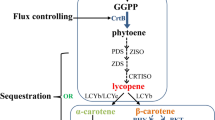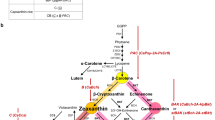Abstract
Ketocarotenoid–biofortified crops are required as natural additives with respect to their Rubi-like reddish color and strong antioxidative properties for foods and feeds. They can be an alternative means of microalgal and bacterial systems and do not depend on chemical synthesis, providing safe, sustainable, and processing-free platforms. To reach sufficient commercial demands, different metabolic engineering strategies have been used in diverse crop plants. In this study, we summarized the current achievements for de novo production of ketocarotenoids in major crops and described host crop-specific tactics to optimize the ketocarotenoid biosynthetic pathway, considering the following different levels and types of carotenoid being accumulated as precursors: lutein and zeaxanthin in maize seeds; lutein in rice seeds, canola seeds, soybean seeds, and tobacco flowers; zeaxanthin in potato tubers; β–carotene in carrot roots; and lycopene in tomato fruits. This study suggests prospects for the advanced performance of ketocarotenoid biofortification in crops in two crucial points: host crop cultivar and the elaborately designed genetic strategies. The latter includes an increase in the total carotenoid capacity by co-consideration to supply precursors and stabilizers, the prevention of metabolite loss in competing or catabolic pathways or both pathways, and the sensible choice of genes and genetic elements for optimal expression. Furthermore, progresses in synthetic biology and new biotechnology, such as genome editing, could accelerate the development of high-valued “Rubi Crops,” which satisfy the nutritional and functional needs of humans and animals.

Similar content being viewed by others
References
Ahn M-J, Noh SA, Ha S-H, Back K, Lee SW, Bae JM (2012) Production of ketocarotenoids in transgenic carrot plants with an enhanced level of β-carotene. Plant Biotechnol Rep 6:133–140
Bai C, Rivera SM, Medina V, Alves R, Vilaprinyo E, Sorribas A, Canela R, Capell T, Sandmann G, Christou P, Zhu C (2014) An in vitro system for the rapid functional characterization of genes involved in carotenoid biosynthesis and accumulation. Plant J 77:464–475
Bai C, Capell T, Berman J, Medina V, Sandmann G, Christou P, Zhu C (2016) Bottlenecks in carotenoid biosynthesis and accumulation in rice endosperm are influenced by the precursor–product balance. Plant Biotechnol J 14:195–205
Bai C, Berman J, Farre G, Capell T, Sandmann G, Christou P, Zhu C (2017) Reconstruction of the astaxanthin biosynthesis pathway in rice endosperm reveals a metabolic bottleneck at the level of endogenous β-carotene hydroxylase activity. Transgenic Res 26:13–23
Breitenbach J, Bai C, Rivera SM, Canela R, Capell T, Christou P, Zhu C, Sandmann G (2014) A novel carotenoid, 4-keto-α-carotene, as an unexpected by-product during genetic engineering of carotenogenesis in rice callus. Phytochemistry 98:85–91
Campbell R, Morris WL, Mortimer CL, Misawa N, Ducreux LJM, Morris JA, Hedley PE, Fraser PD, Taylor MA (2015) Optimising ketocarotenoid production in potato tubers: effect of genetic background, transgene combinations and environment. Plant Sci 234:27–37
Cao H, Luo H, Yuan H, Eissa MA, Thannhauser TW, Welsch R, Hao Y, Cheng L, Li L (2019) A neighboring aromatic-aromatic amino acid combination governs activity divergence between tomato phytoene synthases. Plant Physiol 180:1988–2003
Capelli B, Bagchi D, Cysewski G (2013) Synthetic astaxanthin is significantly inferior to algal-based astaxanthin as an antioxidant and may not be suitable as a human nutraceutical supplement. Nutrafoods 12:145–152
Che P, Zhao ZY, Glassman K, Dolde D, Hu TX, Jones TJ, Gruis DF, Obukosia S, Wambugu F, Albertsen MC (2016) Elevated vitamin E content improves all-trans β-carotene accumulation and stability in biofortified sorghum. Proc Natl Acad Sci USA 113:11040–11045
Chien Y, Shiau W (2005) The effects of dietary supplementation of algae and synthetic astaxanthin on body astaxanthin, survival, growth, and low dissolved oxygen stress resistance of kuruma prawn, Marsupenaeus japonicus Bate. J Exp Mar Biol Ecol 318:201–211
Cunningham F, Gantt E (2011) (2011) Elucidation of the pathway to astaxanthin in the flowers of Adonis aestivalis. Plant Cell 23:3055–3069
Endo A, Saika H, Takemura M, Misawa N, Toki S (2019) A novel approach to carotenoid accumulation in rice callus by mimicking the cauliflower Orange mutation via genome editing. Rice 12:81
Enfissi EMA, Nogueira M, D’Ambrosio C, Stigliani AL, Giorio G, Misawa N, Fraser PD (2019) The road to astaxanthin production in tomato fruit reveals plastid and metabolic adaptation resulting in an unintended high lycopene genotype with delayed over-ripening properties. Plant Biotechnol J 17:1501–1513
Esatbeyoglu T, Rimbach G (2017) Canthaxanthin: from molecule to function. Mol Nutr Food Res 61:1600469
Fang N, Wang C, Liu X, Zhao X, Liu Y, Liu X, Du Y, Zhang Z, Zhang H (2019) De novo synthesis of astaxanthin: from organisms to genes. Trends Food Sci Technol 92:162–171
Farré G, Maiam Rivera S, Alves R, Vilaprinyo E, Sorribas A, Canela R, Naqvi S, Sandmann G, Capell T, Zhu C, Christou P (2013) Targeted transcriptomic and metabolic profiling reveals temporal bottlenecks in the maize carotenoid pathway that may be addressed by multigene engineering. Plant J 75:441–455
Farré G, Perez-Fons L, Decourcelle M, Breitenbach J, Hem S, Zhu C, Capell T, Christou P, Fraser P, Sandmann G (2016) Metabolic engineering of astaxanthin biosynthesis in maize endosperm and characterization of a prototype high oil hybrid. Transgenic Res 25:477–489
Fujisawa M, Takita E, Harada H, Sakurai N, Suzuki H, Ohyama K, Shibata D, Misawa N (2009) Pathway engineering of Brassica napus seeds using multiple key enzyme genes involved in ketocarotenoid formation. J Exp Bot 60:1319–1332
Gerjets T, Sandmann G (2006) Ketocarotenoid formation in transgenic potato. J Exp Bot 57:3639–3645
Gerjets T, Sandmann M, Zhu C, Sandmann G (2007) Metabolic engineering of ketocarotenoid biosynthesis in leaves and flowers of tobacco species. Biotechnol J 2:1263–1269
Giuliano G (2017) Provitamin A biofortification of crop plants: a gold rush with many miners. Curr Opin Biotechnol 44:169–180
Ha S-H, Liang YS, Jung H, Ahn M-J, Suh S-C, Kweon S-J, Kim D-H, Kim Y-M, Kim J-K (2010) Application of two bicistronic systems involving 2A and IRES sequences to the biosynthesis of carotenoids in rice endosperm. Plant Biotechnol J 8:928–938
Ha S-H, Kim JK, Jeong YS, You MK, Lim S-H, Kim J-K (2019) Stepwise pathway engineering to the biosynthesis of zeaxanthin, astaxanthin and capsanthin in rice endosperm. Metab Eng 52:178–189
Hasunuma T, Miyazawa S, Yoshimura S, Shinzaki Y, Tomizawa K, Shindo K, Choi S, Misawa N, Miyake C (2008) Biosynthesis of astaxantyehin in tobacco leaves by transplastomic engineering. Plant J 55:857–868
Huang J, Zhong Y, Liu J, Sandmann G, Chen F (2013) Metabolic engineering of tomato for high-yield production of astaxanthin. Metab Eng 17:59–67
ISAAA (2019) Global status of commercialized biotech/GM crops in 2019. brief’s series 55
Jayaraj J, Jayaraj J, Devlin R, Devlin R, Punja Z, Punja Z (2008) Metabolic engineering of novel ketocarotenoid production in carrot plants. Transgenic Res 17:489–501
Jeong YS, Ku H-K, Jung Y-J, Jung J-J, Kim JK, Lee KB, Kim J-K, Lim S-H, Lee D, Ha S-H (2021) 2A-linked bi-, tri-, and quad-cistrons for the stepwise biosynthesis of β-carotene, zeaxanthin, and ketocarotenoids in rice endosperm. Metab Eng Commun 12:e00166
Liyanaarachchi VC, Nishshanka GKSH, Premaratne RGMM, Ariyadasa TU, Nimarshana PHV, Malik A (2020) Astaxanthin accumulation in the green microalga Haematococcus pluvialis: effect of initial phosphate concentration and stepwise/continuous light stress. Biotechnol Rep 28:e00538
Mann V, Harker M, Pecker I, Hirschberg J (2000) Metabolic engineering of astaxanthin production in tobacco flowers. Nat Biotechnol 18:888–892
Moreno JA, Díaz-Gómez J, Fuentes-Font L, Angulo E, Gosálvez LF, Sandmann G, Portero-Otin M, Capell T, Zhu C, Christou P, Nogareda C (2020) Poultry diets containing (keto)carotenoid-enriched maize improve egg yolk color and maintain quality. Anim Feed Sci Technol 260:114334
Morris WL, Ducreux LJM, Fraser PD, Millam S, Taylor MA (2006) Engineering ketocarotenoid biosynthesis in potato tubers. Metab Eng 8:253–263
Nogueira M, Enfissi EMA, Valenzuela MEM, Menard GN, Driller RL, Eastmond PJ, Schuch W, Sandmann G, Fraser PD (2017) Engineering of tomato for the sustainable production of ketocarotenoids and its evaluation in aquaculture feed. Proc Natl Acad Sci USA 114:10876–10881
Osorio CE (2019) The role of orange gene in carotenoid accumulation: manipulating chromoplasts toward a colored future. Front Plant Sci 10:1235
Panis G, Carreon JR (2016) Commercial astaxanthin production derived by green alga Haematococcus pluvialis: a microalgae process model and a techno-economic assessment all through production line. Algal Res 18:175–190
Pierce EC, LaFayette PR, Ortega MA, Joyce BL, Kopsell DA, Parrott WA (2015) Ketocarotenoid production in soybean seeds through metabolic engineering. PLoS ONE 10:0138196
Ralley L, Enfissi EMA, Misawa N, Schuch W, Bramley PM, Fraser PD (2004) Metabolic engineering of ketocarotenoid formation in higher plants. Plant J 39:477–486
Rebelo BA, Farrona S, Ventura MR, Abranches R (2020) Canthaxanthin, a red-hot carotenoid: applications, synthesis, and biosynthetic evolution. Plants 9:1039
Rosa AP, Scher A, Sorbara JOB, Boemo LS, Forgiarini J, Londero A (2012) Effects of canthaxanthin on the productive and reproductive performance of broiler breeders. Poult Sci 91:660–666
Shewmaker CK, Sheehy JA, Daley M, Colburn S, Ke DY (1999) Seed-specific overexpression of phytoene synthase: increase in carotenoids and other metabolic effects. Plant J 20:401–412
Si X, Zhang H, Wang Y, Chen K, Gao C (2020) Manipulating gene translation in plants by CRISPR–Cas9-mediated genome editing of upstream open reading frames. Nat Protoc 15:338–363
Tian Y, Wang B, Peng R, Xu J, Li T, Fu X, Xiong A, Gao J, Yao Q (2019) Enhancing carotenoid biosynthesis in rice endosperm by metabolic engineering. Plant Biotechnol J 17:849–851
Tran NT, Kaldenhoff R (2020) Metabolic engineering of ketocarotenoids biosynthetic pathway in Chlamydomonas reinhardtii strain CC-4102. Sci Rep 10:10688
You MK, Lee YJ, Kim JK, Baek SA, Jeon YA, Lim SH, Ha S-H (2020) The organ-specific differential roles of rice DXS and DXR, the first two enzymes of the MEP pathway, in carotenoid metabolism in Oryza sativa leaves and seeds. BMC Plant Biol 20:167
Yuan J, Peng J, Yin K, Wang J (2011) Potential health-promoting effects of astaxanthin: a high-value carotenoid mostly from microalgae. Mol Nutr Food Res 55:150–165
Zhang H, Si X, Ji X, Fan R, Liu J, Chen K, Wang D, Gao C (2018) Genome editing of upstream open reading frames enables translational control in plants. Nat Biotechnol 36:894–898
Zheng X, Giuliano G, Al-Babili S (2020) Carotenoid biofortification in crop plants: citius, altius, fortius. Biochim Biophys Acta Mol Cell Biol Lipids 1865:158664
Zhu C, Naqvi S, Breitenbach J, Sandmann G, Christou P, Capell T (2008) Combinatorial genetic transformation generates a library of metabolic phenotypes for the carotenoid pathway in maize. Proc Natl Acad Sci USA 105:18232–18237
Zhu C, Naqvi S, Capell T, Christou P (2009) Metabolic engineering of ketocarotenoid biosynthesis in higher plants. Arch Biochem Biophys 483:182–190
Zhu Q, Zeng D, Yu S, Cui C, Li J, Li H, Chen J, Zhang R, Zhao X, Chen L, Liu Y (2018) From golden rice to aSTARice: bioengineering astaxanthin biosynthesis in rice endosperm. Mol Plant 11:1440–1448
Zhu Q, Wang B, Tan J, Liu T, Li L, Liu Y (2020) Plant synthetic metabolic engineering for enhancing crop nutritional quality. Plant Commun 1:100017
Acknowledgements
This work was supported by BioGreen21 Agri-Tech Innovation Program (PJ01567101 to S.-H. Ha) and the Next Generation New Plant Breed Technology Program (PJ01477202 to S.-H. Ha) funded by the Rural Development Administration, Republic of Korea.
Author information
Authors and Affiliations
Contributions
YSJ and H-KK drafted the manuscript with J-YL; S-HH envisaged and revised the paper with DL. All authors reviewed and approved the final manuscript.
Corresponding authors
Ethics declarations
Conflict of interest
The authors declare no conflicts of interest.
Additional information
Publisher's Note
Springer Nature remains neutral with regard to jurisdictional claims in published maps and institutional affiliations.
Rights and permissions
About this article
Cite this article
Jeong, Y.S., Ku, HK., Lee, JY. et al. Rubi-colored crops with built-in ketocarotenoid biosynthetic pathway. Plant Biotechnol Rep 15, 125–138 (2021). https://doi.org/10.1007/s11816-021-00673-6
Received:
Revised:
Accepted:
Published:
Issue Date:
DOI: https://doi.org/10.1007/s11816-021-00673-6




